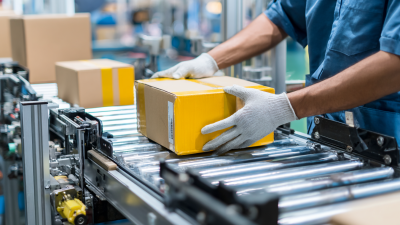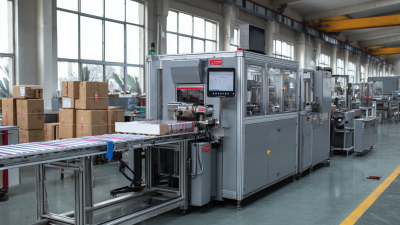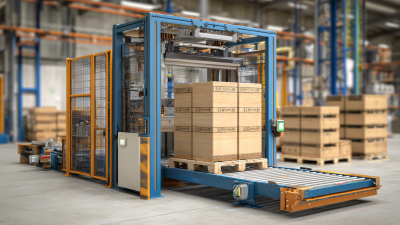A-B-C Blog
How to Optimize Your Production Line with a Hot Melt Machine
In today’s fast-paced manufacturing landscape, optimizing production efficiency is a critical goal for any business aiming to stay competitive. One powerful tool that has emerged to enhance production lines is the Hot Melt Machine. This innovative equipment not only streamlines adhesive application processes but also significantly reduces downtime and waste. By leveraging advanced hot melt technology, manufacturers can achieve remarkable improvements in product quality, flexibility, and cost-effectiveness. In this blog, we will explore the best practices for integrating a Hot Melt Machine into your production line, highlighting practical strategies and real-world examples that illustrate the benefits of this essential tool. Whether you are looking to upgrade your existing setup or implement a new system, understanding how to effectively utilize a Hot Melt Machine will be a game-changer for your operations.

Identifying Key Areas for Improvement in Your Production Line
Identifying key areas for improvement in your production line is crucial for maximizing efficiency, especially when integrating a hot melt machine. According to a recent report by Smithers Pira, hot melt adhesive applications are projected to grow at a compound annual growth rate (CAGR) of 4.9% through 2026, underscoring the increasing importance of automation and quality in manufacturing processes. By analyzing workflow bottlenecks, businesses can determine where a hot melt machine will provide the greatest impact, eliminating slowdowns related to manual adhesive application.
One primary area to focus on is the speed and consistency of adhesive application. A study from the Adhesive and Sealant Council highlights that inconsistencies in adhesive use can lead to a 10% increase in production costs due to wasted materials and rework. Implementing a hot melt machine can streamline this process, providing precise application that minimizes waste and enhances product quality. Furthermore, investing in a hot melt solution can also improve overall line efficiency by reducing downtime associated with adhesive changeovers and maintenance, as these machines are designed for quick and easy alterations.

Understanding the Types of Hot Melt Machines and Their Applications
Hot melt machines have become integral to modern manufacturing processes, offering versatility and efficiency across various applications. Understanding the types of hot melt machines is crucial for companies looking to optimize their production lines. Broadly, there are two main categories of hot melt machines: the tank and the extrusion type. Tank machines are designed for low to medium production volumes, where adhesive is stored in a heated tank, ensuring continuous flow. These machines excel in processes like packaging, bookbinding, and automotive assembly.
On the other hand, extrusion hot melt machines are ideal for high-volume applications. They extrude adhesive in a continuous manner, making them perfect for tasks such as applying adhesive for labels, woodworking, and textile bonding. Additionally, there are specialty machines that cater to specific needs, such as the case and tray sealers that enhance product protection. By carefully selecting and implementing the right type of hot melt machine, manufacturers can significantly enhance efficiency, reduce waste, and improve product quality across their production lines.
Creating a Step-by-Step Implementation Guide for Hot Melt Systems
Implementing a hot melt adhesive system in your production line can significantly enhance efficiency and product quality. According to a report by the Adhesive and Sealant Council, the global hot melt adhesive market is expected to reach approximately $8 billion by 2023, highlighting its growing importance in various industries including packaging, automotive, and construction. This growth signals a rising trend in production optimization priorities among manufacturers.
To successfully integrate a hot melt system, start with a thorough analysis of your current production processes. Identify key areas where adhesive application can be improved, such as speed and precision. The application of hot melt can reduce bonding times by up to 50%, enabling higher throughput. Next, develop a step-by-step implementation guide, which includes selecting the right type of adhesive for your specific application, ensuring compatibility with existing machinery, and conducting training sessions for your team. Data from industry leaders show that companies adopting structured implementation strategies have seen a 30% increase in operational efficiency within the first year.
Establishing Maintenance and Quality Control Procedures for Consistency
Establishing robust maintenance and quality control procedures is essential for optimizing your production line with a hot melt machine. Consistency in operations can significantly reduce downtime and improve overall efficiency. To start, it’s crucial to implement a regular maintenance schedule, which includes weekly inspections and servicing of the machine. This proactive approach helps in identifying potential issues before they escalate, ensuring that the hot melt machine operates at peak performance.
In parallel, developing strict quality control procedures is vital for maintaining product integrity. This can involve regular testing of adhesive bonds and application patterns to ensure that they meet the specified standards. Training your team on these procedures not only enhances their understanding of the equipment but also fosters a culture of quality within the workplace. By closely monitoring both the maintenance routines and quality checks, manufacturers can achieve a streamlined production process that yields reliable and consistent results.
How to Optimize Your Production Line with a Hot Melt Machine - Establishing Maintenance and Quality Control Procedures for Consistency
| Dimension | Description | Frequency | Metrics |
|---|---|---|---|
| Preventive Maintenance | Routine checks and servicing of hot melt machines to prevent breakdowns. | Monthly | Machine Uptime (%) |
| Quality Control Inspections | Assessing the quality of products produced using hot melt adhesives. | Weekly | Defect Rate (%) |
| Adhesive Testing | Testing the properties of adhesives used in production. | Quarterly | Viscosity (cP) |
| Operator Training | Training programs for operators on machine handling and quality standards. | Biannually | Training Completion Rate (%) |
| Equipment Calibration | Calibration of machines to ensure accurate application of adhesive. | Annually | Calibration Success Rate (%) |
Training Your Team: Best Practices for Operating Hot Melt Machines
Training your team effectively is crucial for maximizing the efficiency of operations involving hot melt machines. According to industry studies, companies that invest in comprehensive training programs can improve production efficiency by up to 30%. Ensuring that your operators are well-versed in the specific machinery enhances not only output but also reduces the likelihood of operational errors that can lead to costly downtime.
Tip: Implement hands-on training sessions that mimic real production scenarios. This can help your team become familiar with troubleshooting common issues, ultimately leading to quicker resolutions during actual production runs. Additionally, regular refresher courses can keep your team's skills sharp and up to date with the latest technology and best practices.
As the integration of advanced technologies becomes more prevalent, it's important to emphasize the need for continuous learning. The incorporation of AI in modern operations is an example of how industries are evolving. While the military is exploring AI to enhance efficiency and decision-making, similar strategies can be applied in manufacturing settings. By fostering a culture of innovation and adaptability, your team can stay ahead in an ever-changing environment, optimizing both workflow and productivity.
Tip: Encourage feedback from your team regarding the training process and any challenges they encounter. This continuous loop of improvement can help refine training practices and align them with current industry standards.

Related Posts
-

Understanding the Challenges with Best Container Packaging Solutions
-

Exploring Innovations in Package Machine Design with 2023 Industry Trends and Data
-

Finding Quality Suppliers for Best Wrap Around Case Packers Essential Checklist for Global Buyers
-

Navigating Tariff Challenges: How China's Best Robotic Palletizer Drives Global Supply Chain Growth
-

Unmatched Quality in Global Export of Premium Industrial Packing Machines Made in China
-

15 Best Pallet Dispenser Machines for Efficient Packaging Solutions






